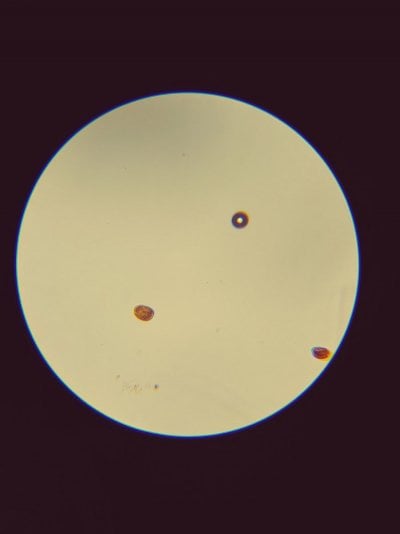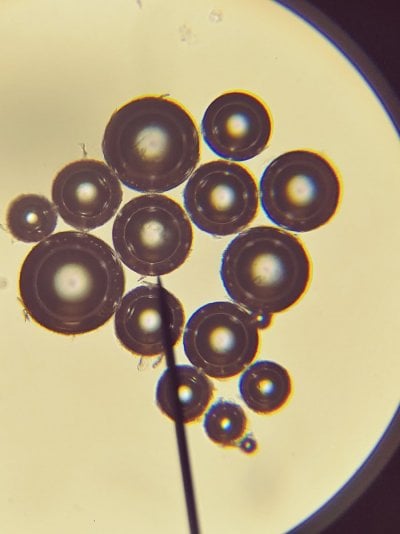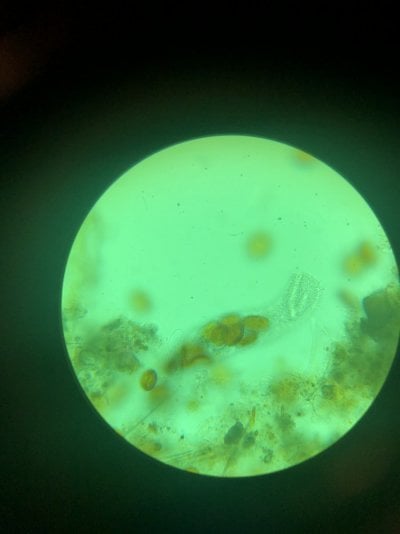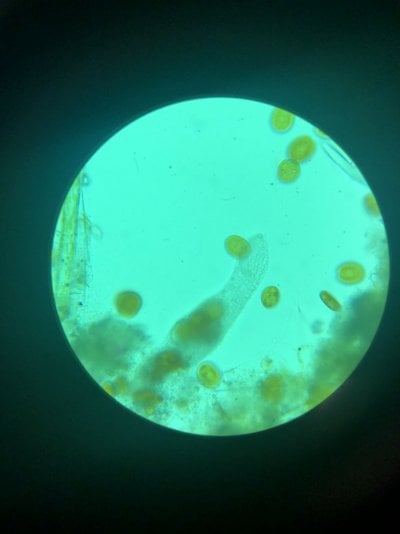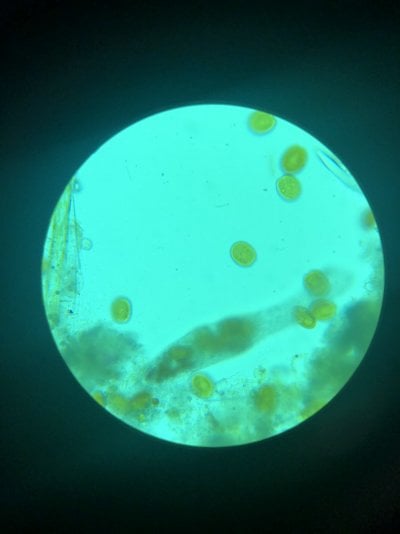Any idea what are the circles in the pictures below? I seen a few from time to time but this past weekend I spotted multiple all connected, looked pretty cool. I been search online but no positive ID.
Navigation
Install the app
How to install the app on iOS
Follow along with the video below to see how to install our site as a web app on your home screen.
Note: This feature may not be available in some browsers.
More options
You are using an out of date browser. It may not display this or other websites correctly.
You should upgrade or use an alternative browser.
You should upgrade or use an alternative browser.
Dinoflagellates – Are You Tired Of Battling Altogether?
- Thread starter mcarroll
- Start date
- Tagged users None
They are UFOs certainly.Any idea what are the circles in the pictures below? I seen a few from time to time but this past weekend I spotted multiple all connected, looked pretty cool. I been search online but no positive ID.
The nano type. Case closed.
Those look like bubbles between the slide and the cover slip.Any idea what are the circles in the pictures below? I seen a few from time to time but this past weekend I spotted multiple all connected, looked pretty cool. I been search online but no positive ID.
Acronym = Unidentified Floating Object?They are UFOs certainly.
Could be, initially I thought it was some type of sponge as I only saw them individually but on the second picture there were all bunch together almost look like a molecular structure. Kind of resemble the ones in the link below which is bleachThose look like bubbles between the slide and the cover slip.
bleach-liquid-flowing-filmed-under-microscope-super-macro-sh
Real dumb question here....but would transferring 2 clowns from this infected tank to another tank carry the dinos over?
- Joined
- Mar 20, 2018
- Messages
- 88
- Reaction score
- 42
It was older, probably not big enough as it was for a green water issue I had on a planted shrimp tank years back but I had to throw it away because it was damaged close to where the wire enters the equipment and I was afraid I’d electrocute myself. Will buy one and go that route if needed. Going to give it a little more time of nutrient balancing..I recall that you have a UV, but somehow you question whether or not it is working effectively. A blackout is a good idea if the prorocentrum aren't taking to the WC at night. But unless the UV is effective it is a waste.
So just checking:
a) bulb is <12 months old
b) 1 watt per 3 gallons
c) to/from affected display (not in line through return pump)
d) slow flow. depending on size 2-300 gph.
Had a good sign today. I’ve been refraining from cleaning the glass and found that my snails are eating the stuff of the glass and thought, man they can’t be eating dinos so let me look under the scope. Sure enough, we have a lot of competition growing! Bunch of diatoms that look to be feeding on something else here. Good stuff!
- Joined
- May 22, 2016
- Messages
- 6,970
- Reaction score
- 10,747
If you can't pipette up brown gunk off the sand and get high concentration of dinos in the scope, then you don't have a dino problem, IMO.I would put about a tablespoon of dirty sand in a small plastic vial with just enough tank water to cover it. I would shake it violently for a minute or so and could usually only see 4-5 dinos in a whole slide....mainly saw detritus and diatoms.
So......how do you recommend preparing a slide of dinos growing on a sand bed.?
maybe. It's fairly low risk. You could transfer to another holding tank mostly in the dark for a couple of days, before their final destination and take the risk down to near zero. Adding more transfers may not be better for the clowns, but would lower the risk of dinos moving with them.Real dumb question here....but would transferring 2 clowns from this infected tank to another tank carry the dinos over?
If you can't pipette up brown gunk off the sand and get high concentration of dinos in the scope, then you don't have a dino problem, IMO.
This.
I, unfortunately, have no problem getting amphidinium sample off of my sandbed with my giant pipette.
Will see if adding MB7 will do anything. A month of 2ppm Si doesn't seem to be helping, yet.
Thanks @taricha this is my 20 nano. Im prepared to take this thing apart. Im ready to just focus on my 75. The 2 clowns will transfer over permanently after some time in QT. Im not sure about coral. Being attached to rock thats covered in dino, may put the rock in a tote and treat separately? At this point, Id be happy to just keep the acans to transfer. Thoughts on the coral/rock? Appreciate it
It is not a dumb question, rather, it is an interesting one that I have some experience with.Real dumb question here....but would transferring 2 clowns from this infected tank to another tank carry the dinos over?
In the long run, you have to assume all your systems will be exposed to dinos. The question of whether or not you will notice is based upon how hospitable each system is to dino COMPETITORS.
Is there sufficient and stable nutrient to support algae and bacterial growth? Is there already a healthy bacterial film and algae film established? How is the diatom population? How about some coralline?
If you can say "Yes" to the first three, you don't have a friendly environment to support a dino bloom regardless of exposure. Each time you answer "No", your odds keeping dinos at bay are reduced.
I lived through this experiment first hand over a year or two while building out my frag system. In the end, I had 3 tanks in the system all daisy chained together. I built it incrementally though. Each time I added a new tank to the existing system, the NEW TANK only would get a dino breakout while the existing tank(s) would not. The new tank was hospitable to dinos, while the "old" part of the system was not as it had competitive slime, films, algae, diatoms, coralline, etc.
So my answer is: it depends.
Just what I needed to hear, thanks. The 75 is almost 2 years old. Stable nutrients...5/.08. Struggle a little with Ph(im working on a plan), but coralline everywhere. I have to clean glass every 3-4 days so I think diatoms are good. I think I have a good idea why the dinos started in my nano...see what you think.It is not a dumb question, rather, it is an interesting one that I have some experience with.
In the long run, you have to assume all your systems will be exposed to dinos. The question of whether or not you will notice is based upon how hospitable each system is to dino COMPETITORS.
Is there sufficient and stable nutrient to support algae and bacterial growth? Is there already a healthy bacterial film and algae film established? How is the diatom population? How about some coralline?
If you can say "Yes" to the first three, you don't have a friendly environment to support a dino bloom regardless of exposure. Each time you answer "No", your odds keeping dinos at bay are reduced.
I lived through this experiment first hand over a year or two while building out my frag system. In the end, I had 3 tanks in the system all daisy chained together. I built it incrementally though. Each time I added a new tank to the existing system, the NEW TANK only would get a dino breakout while the existing tank(s) would not. The new tank was hospitable to dinos, while the "old" part of the system was not as it had competitive slime, films, algae, diatoms, coralline, etc.
So my answer is: it depends.
-went hunting for 1 week
-my son was to refill ato rez mid week.
-came back to all dead/dying Euphyllia
- sand 100% covered in cyano(BAD)
-I believe he accidentally topped off with tap instead of the RODI rez.
-vac'd what cyano I could, then ended up treating with Chemi-clean. Wiped it all out
-Id say within a week dinos showed up.
Nanos are tough. Just not enough volume to dilute the smallest of errors. Any mortality from an error can so quickly cascade through the biome web. Chemiclean: Some folks dispute this, but if you make it through a few hundred pages of this thread, you come to the anecdotal conclusion that Chemiclean is a major catalyst for kicking off a dino bloom. It kills some kind(s) of competitor that had been constraining their population.Just what I needed to hear, thanks. The 75 is almost 2 years old. Stable nutrients...5/.08. Struggle a little with Ph(im working on a plan), but coralline everywhere. I have to clean glass every 3-4 days so I think diatoms are good. I think I have a good idea why the dinos started in my nano...see what you think.
-went hunting for 1 week
-my son was to refill ato rez mid week.
-came back to all dead/dying Euphyllia
- sand 100% covered in cyano(BAD)
-I believe he accidentally topped off with tap instead of the RODI rez.
-vac'd what cyano I could, then ended up treating with Chemi-clean. Wiped it all out
-Id say within a week dinos showed up.
IMO, you are safe to sling anything from the nano into the 75 without worry. There is no way that dinos are not already in that system. In fact the next time you scrape the glass, put some gunk under the 'scope. I'd bet your paycheck you will find one or two little buggers in there. I can find them in both my systems 18 months after I "beat" ostreopsis. They are lurking, waiting for their chance.
Just keep the competition healthy. (And stay away from Chemiclean, IMO.)
- Joined
- Mar 20, 2018
- Messages
- 88
- Reaction score
- 42
Ok this is good. Now that I’ve been nitrate dosing and adding bacteria and phytoplankton, I am seeing a lot more mixed in with the dinos when I sample the slime on my rocks. Even two little guys eating dinos right before me on my slide! How cool is that! What are these and how do I purchase 7 billion of them? 
Attachments
Very cool. Several pages back is a video of the same predation on LC amphidinium.Ok this is good. Now that I’ve been nitrate dosing and adding bacteria and phytoplankton, I am seeing a lot more mixed in with the dinos when I sample the slime on my rocks. Even two little guys eating dinos right before me on my slide! How cool is that! What are these and how do I purchase 7 billion of them?
- Joined
- May 22, 2016
- Messages
- 6,970
- Reaction score
- 10,747
Ciliate eating prorocentrum dinoflagellates!Even two little guys eating dinos right before me on my slide! How cool is that!
I also found several kinds of ciliates (though not the one you posted) eating dinos in my systems. And played around with culturing them but that was a total flop.
Hard to find a food source to grow ciliates that eat dinos. And precise identification is a nightmare.
Ciliate eating prorocentrum dinoflagellates!
I also found several kinds of ciliates (though not the one you posted) eating dinos in my systems. And played around with culturing them but that was a total flop.
Hard to find a food source to grow ciliates that eat dinos. And precise identification is a nightmare.
But if you could do it.......!!!! People (I) would pay big time for a simple solution like a predator. Kind of like Berghia nudibranchs for aiptasia!
Last edited:
Hello all, been reading through here for a while and battling. I’ve recently begun dosing neonitro and finally have a 5-10ppm reading on a salifert kit. Awaiting a better phosphate kit-but api shows 0. Started dosing phytoplankton as well. My dinos seemed to come back with a vengeance after a 3 day blackout (started dosing after the blackout), so I ordered a uv sterilizer too. That’s finally hooked up-will the uv sterilizer basically negate the addition of the phytoplankton? Attached is one of the best pics I could get they moved in a circle around a point

Sorry, but for me this pic is inconclusive so lets work with what you saw.Hello all, been reading through here for a while and battling. I’ve recently begun dosing neonitro and finally have a 5-10ppm reading on a salifert kit. Awaiting a better phosphate kit-but api shows 0. Started dosing phytoplankton as well. My dinos seemed to come back with a vengeance after a 3 day blackout (started dosing after the blackout), so I ordered a uv sterilizer too. That’s finally hooked up-will the uv sterilizer basically negate the addition of the phytoplankton? Attached is one of the best pics I could get they moved in a circle around a point
Moving in a circle like a Roomba vacuum does? Like bumper cars? Or moving in a circle as if they were tethered?
What I see is not almond-shaped, but what do you see?
It moves like it’s tethered to a string, like the planets around the sun. Very round and not almond shaped from what I see. I am not home now but will try to get better pictures tomorrow. This red stuff starts to get real bubbly the longer lights are on, and in the morning there’s hardly any air bubbles at all This red stuff will cover most of the rock (some bare spots) if left unchecked. I try to siphon out by filtering through a bag letting water drain back into sump.

Similar threads
- Replies
- 43
- Views
- 544
- Replies
- 1
- Views
- 89
- Replies
- 4
- Views
- 251


